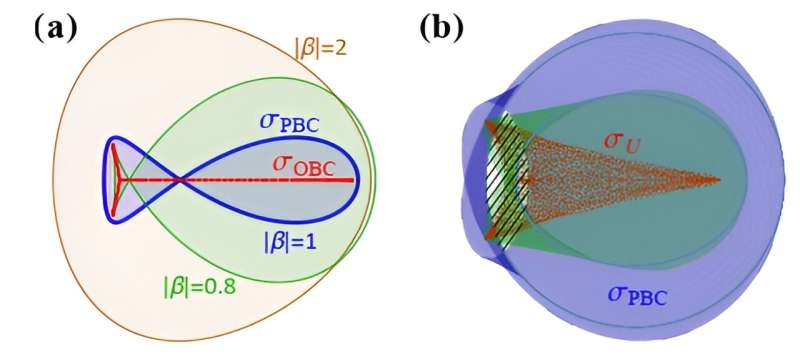This article has been reviewed according to Science X's editorial process and policies. Editors have highlighted the following attributes while ensuring the content's credibility:
fact-checked
trusted source
proofread
Non-Hermitian skin effect in all dimensions tied to point-gap topology

A study, published in the journal Science Bulletin and led by Dr. Haiping Hu from the Institute of Physics, Chinese Academy of Sciences (IOP, CAS), explores the non-Hermitian skin effect (NHSE) and non-Bloch bands.
Non-Hermitian physics is a rapidly growing field that has made remarkable progress in recent years. The NHSE is a paradigmatic phenomenon of non-Hermitian systems, marked by the extensive accumulation of eigenstates at the boundaries and the extreme sensitivity of energy spectra to boundary conditions. NHSE challenges traditional Bloch band theory and offers exciting new ways to control wave phenomena and design functional devices.
NHSE can occur in different spatial dimensions and is closely related to the system's open boundary conditions (OBC). In one dimension (1D), the OBC is definite, making NHSE well-understood and describable by non-Bloch band theory. However, in higher dimensions, the diversity of lattice geometries complicates the OBC.
Fundamental questions about NHSE in higher dimensions remain unanswered, such as: How can energy spectra and skin effects be systematically accounted across various lattice geometries? What is the topological origin of NHSE in higher dimensions? How are the skin modes associated with different lattice cuts interconnected?
Dr. Hu drew inspiration from studies of 1D NHSE. In 1D, NHSE arises from point gaps, where energy spectra under periodic boundary conditions form loops in the complex plane. Obtaining the non-Bloch spectra requires eliminating the windings caused by these loops. Dr. Hu revealed that by introducing virtual gauge transformations in higher dimensions, it is possible to account for spectral windings in all directions and then eliminate these windings to obtain the system's non-Bloch spectra.
This method produces spectral structures that are independent of geometry. Dr. Hu further demonstrated that his non-Bloch spectra are equivalent to those described by the renowned Amoeba theory. This approach also reveals how to handle NHSE in diverse lattice geometries.
Since skin modes are localized at the boundaries, it is necessary to analytically continue the lattice momenta in the Bloch Hamiltonian. Dr. Hu found that different geometries correspond to different choices of momentum basis. Through basis transformations, NHSE under different geometries can be managed, and the properties of skin modes under different geometries follow specific transformation relations.
This work significantly advances the understanding and exploration of NHSE, offering guidelines for manipulating skin modes through appropriate lattice tailoring. The findings open up broad avenues for further theoretical and experimental investigations in optical and photonic systems, cold atoms, acoustics, metamaterials, and other non-conservative systems.
More information: Haiping Hu, Topological origin of non-Hermitian skin effect in higher dimensions and uniform spectra, Science Bulletin (2024). DOI: 10.1016/j.scib.2024.07.022
Provided by Science China Press





















